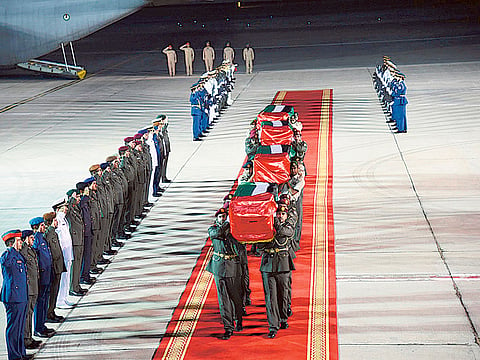UAE committed to stand by Yemenis seeking legitimacy
Country has not spared military and humanitarian efforts to restore peace, security

Abu Dhabi: The UAE, along with Saudi Arabia and other members of the Arab coalition, has been fighting for the past year, losing precious lives in the process, in a valiant effort to free the Yemeni people from the repression of militant Al Houthis.
Analysts say as more and more provinces are being liberated and the legitimate government is able to return to Aden to perform its duties, the results so far have been promising, and the coalition has now set its sight on the liberation of Yemeni capital Sana’a.
“The UAE’s role in the Yemen operation is on a whole a successful illustration of a mix of air force and other services to achieve major strategic and tactical goals. What is most impressive is that the UAE Armed Forces are able to project in to Yemen with a healthy logistics chain that not only includes air capabilities but also the delivery of land-based assets to key ports, specifically Aden. These operations feature many successes in projection capability,” said Dr Theodore Karasik, Senior Adviser, Gulf State Analytics.
Dr Karasik told Gulf News that success can be measured in two ways. “First, UAE operations in Yemen achieved multiple goals of shaking up the local chessboard to bring the Hadi government back into the beleaguered country but also preparing the ground for offensives around Sana’a and into Taiz. Second, UAE military personnel are receiving a real-world experience in protecting their homeland, the UAE. This fact, despite fallen martyrs, who are UAE heros, sets a new and important standard for UAE pride and honour that will influence current and future generations.”
The UAE has lost more than 70 soldiers in the Yemen campaign — the largest number of martyrs in any single conflict the country has intervened — heroes who have laid down their lives to bring Yemen back on its feet. Nevertheless, its commitment to Yemen remains determined.
Operation Decisive Storm (and subsequently Operation Restoring Hope) came just three weeks after Yemen’s president, Abd Rabbo Mansour Hadi, appealed to the rulers of the UAE, Saudi Arabia, and other GCC member countries for help in “protecting Yemen” by providing “instant support by all necessary means, including military intervention, to protect Yemen and its people from the continuous Al Houthi aggression”.
His Highness Shaikh Mohammad Bin Zayed Al Nahyan, Crown Prince of Abu Dhabi and Deputy Supreme Commander of the UAE Armed Forces, repeatedly told Yemeni officials and people the UAE will be with them until the mission is accomplished, pledging incessant military and humanitarian efforts to restore peace, security and stability to Yemen.
Dr Karasik said the timetable for UAE operations is subject to a multitude of factors, including stability operations, ongoing talks between Al Houthis and Saudi Arabia, and other local factors. “Thus, an important driver continues to be the use of military and political tools to achieve the desired effects on the ground. The UAE is relying on coalition partners to step up diplomacy and their own operations while the UAE footprint is adjusted. Significantly, the UAE is always prepared to up their operational tempo when and if necessary to achieve the desired effect,” Dr Karasik concluded.
The UAE replaced its troops in Yemen early in November last year as the Arab coalition forces and their national allies are fighting the final battle to seize Taiz and end an Iranian-backed coup and restore legitimacy to Yemen.
Emirati analyst Dr Abdul Khaleq Abdullah said the UAE joined the Arab coalition with a clear purpose: to prevent Iran-backed Al Houthi militants from gaining a foothold in Yemen, from where they could destabilise neighbouring Saudi Arabia. “There was a collective Gulf need to stand up to expansionist Iran. Yemen was the place to draw the line,” Dr Abdullah said.
Abdullah stressed the UAE is in Yemen because inaction would have been strategically and politically more costly in the long run than action.
On the humanitarian front, Emirates Red Crescent continues to work hard to respond to the pressing humanitarian needs in Yemen, providing food and relief materials to more than 300,000 households or approximately 2.1 million people since Aden was liberated.
The UAE became the world’s largest aid donor to Yemen last year, providing humanitarian aid worth Dh744 million ($202 million) between April and July — almost half of the aid pledged by other countries. The UAE’s total assistance worth more than Dh900 million ($252 million) was granted to the Yemeni people since the beginning of the crisis.
The range of help the UAE is giving Yemen is vast and covers food and relief supplies as well as rebuilding schools and hospitals.
Sign up for the Daily Briefing
Get the latest news and updates straight to your inbox



